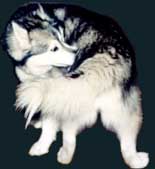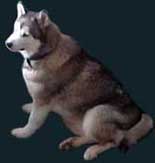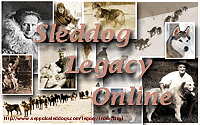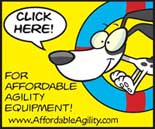
Weight Pulling - A Basic Introduction

From: Missy Kehler at The Working Canine
Canine weight pulling can trace its history back to the days of Alaska's goldrush. It's there that miners, trappers, and others would bet money to see who had the strongest dog. Most of us are familiar with the dog, Buck, from Jack London's "Call of the Wild". Buck was asked to pull a heavily loaded sled that was frozen to the ground a certain distance, while spectators bet on whether or not he could do it. Buck worked the sled from side to side until it broke free. He successfully pulled the heavy sled to his handler.
Canine weight pulling has changed dramatically since the goldrush days. Now events are sanctioned through various organizations throughout the United States and Canada, even branching out to European countries. All breeds of dogs compete, and their safety is of the utmost concern for all involved.
The popularity of weight pulling is increasing. It is a sport in which the average person and dog can compete. Most events are also very family oriented, making it easy for everyone to enjoy whether you are young or old.
The objective of weight pulling is to see who has the strongest dog and best trained dog in an organized, safe and professional competition. The dogs are first divided into classes abased upon their weight so that they can compete with other dogs of comparable size. Dogs are then asked to pull a loaded sled or cart the distance of 16 feet within 60 seconds. The weights start off light, and with each round more weight is added. The dogs that cannot pull the weight are eliminated from competition. The dog that pulls the most weight wins the class. If two or more dogs pull the same amount of weight, then the winner is determined by time.
The exact rules of weight pulling will vary depending upon the organization that is hosting the pull. Most weight pull rules are based upon the same guidelines, but there are differences. When competing at a weight pull, be aware of the rules under which you are competing. Also keep in mind that some organizations are breed specific while others allow all breeds, including mixes, to compete.
In general, weight pulling is open to any dog regardless of its breed, size, sex or age. Popular "pulling" breeds are Alaskan Malamutes, Mastiffs, American Bulldogs and Pitbulls, but there have been other breeds such as Jack Russels, poodles, shepherds and retrievers. Even the average mutt from the local animal shelter is welcome at some of the competitions. Don't let size fool you either. Sometimes smaller dogs can pound for pound, out pull the largest of the dogs.
Regardless of the breed, the most important factor is the dog's health. Working dogs should have sound hips, bones and joints. They should be up to date on vaccines and free of parasites. They shouldn't have any type of debilitating diseases like heart disease, liver problems or kidney problems. A thorough vet visit is in order if you plan on working your dog. This visit will help to ensure that your dog is healthy and ready to work.
The dog's age is another important factor. Most organizations will allow you to compete in pro classes when the dog is between 1 year old and 12 years old. Again, this will vary between organizations. Puppies can begin a specialized training program as young as 8 weeks. And yes, you can teach an old dog new tricks. Mature dogs can be trained to weight pull also.
The general temperament of your dog is going to be a factor, also. Weight pulling is not only a physical sport, but a mental sport as well. Dogs that are shy or easily spooked by people and noises will be harder to train and compete with. Dogs that are aggressive will be more interested in wasting energy on picking fights vs. working. Most organizations will not allow human aggressive dogs to compete. This is not to say that if your dog is shy or aggressive, that it won't pull for you. It just means that you will have to work harder at training your dog.
The harness is the most important piece of equipment that you will need for weight pulling. There are 2 types of harnesses that are acceptable for weight pulling. They are the freighting harness and the weight pulling harness. Both harnesses are designed to take the weight off the dog's hindquarters and place it on the chest and shoulders of the dog when pulling a heavy load. The harness is well padded with faux fur or fleece to prevent chafing and the nylon from cutting into the dog when in use.
The freighting harness came before weight pulling was an organized sport. It is primarily used for hauling heavy weights long distance by way of dog sled. The freight harness is usually made of 1" wide nylon webbing with padding on the neck and breastplate. It also has a spreader bar (wooden dowel) placed behind the dog's back legs close to the point of hookup. The spreader bar on a freight harness is usually closer to the dog's backend, and the ring used for hookup is generally smaller. It is designed this way so that the dog doesn't become tangled in the harness when running on a sled team. Freight harnesses are acceptable for weight pulling since it is designed to haul heavy loads.
The weight pulling harness is similar to the freight harness. Generally, this harness is made of up to 2" wide nylon webbing and is padded around the neck, breast, and along the sides to the spreader bar. The spreader bar is usually larger on a weight pulling harness and is not placed so close to the dog's backend. This way less pressure is placed on the dog's hindquarters and is given more room to work a very heavy load. Weight pulling harnesses can also extend farther out the backend, usually not more than 24" at the point of hookup. The ring used for hookup is also larger.
You can cause injury to your dog by placing unnecessary strain on their back!
Harness fit is another important factor. Dogs should have a properly fitted harness for training and competition. A Properly fitted harness will allow the dog to perform at its highest potential and ensure the safety of the dog. Harnesses should fit snug around the neck. A loose or tight fitting harness will restrict your dog's movements or press on his windpipe. The harness should also be long enough for the dog to comfortably work in it, but not so loose that the dog gets tangled. The fit of the harness should be checked regularly. It should be adjusted accordingly when needed. Watch your dog while training and note any adjustments that need to be made.
Remember, your dog cannot tell you how the harness fits by talking to you. You must watch his movements to determine what a comfortable fit is for your dog. If you are unsure of the fit of the harness, by all means ask someone who is experience in weight pulling to check it for you.
Another point to keep in mind with the harness is your dog's age. Puppies and young dogs are going to need more than one harness as they grow. Generally dogs are not full grown until they are at least 1 year old, and will take an additional year to fill out. Larger breeds can take up to 4 years before they are fully grown.
Let your dog smell the harness first. Slowly place the head through the neck hole, pushing it down into place. Work the collars and leashes through the neck hole so that they rest between the dog's head and harness. The harness should rest comfortably at the base of the dog's neck with one cross section resting on the top of his breastbone and the other cross section resting on his shoulder blades.
The breastplate should be resting against your dog's breast. Pick you dog's front legs up one at a time. Pull the leg between the breastplate and the first side strap. Once both front legs are in place, finish extending the harness out to the back of your dog. If you did this correctly, the harness will come from the breastplate under your dog, behind the front legs, and run along side your dog.
Go slowly the first few times you harness your dog. Give lots of praise! Most dogs will look at you like you are insane the first few times you harness him. But look out once he gets the idea of what the harness is all about!
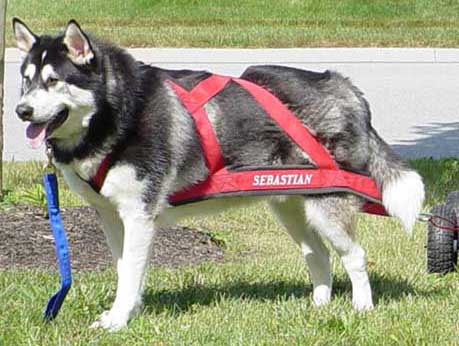
This is how your dog should look when properly harnessed.
Start the dog off by just letting the harness on for short periods of time. Let the dog walk around with the harness on so that he can get used to the feel of it. Take him for walks sporting his new "duds" or even play fetch in it. Show him that the harness is a fun thing to wear. The idea of this is to accustom the dog to the harness, and making it a positive experience.
Once your dog is used to the harness, place small drag weights behind him. Drag weights can be defined as anything that can be safely and easily dragged behind the dog that will give resistance and will not roll or bump into the dog. Great beginner drag weights are light chains. They give some resistance, but not too much to deter the dog. They also don't roll into the dog, and they make lots of noise for the dog to get used to. Have your dog drag the weight around. Again, make it a game and by all means make it fun! If your dog seems scared, talk him through it. Be reassuring with your dog. The idea is to build up his confidence.
Your training sessions should be about 15 minutes, 3-4 times a week. You should always pull on dirt or grass. Never pull on asphalt or concrete. This will tear up your dog's paws.
When he is confidently pulling the light weights, add some slightly heavier weights to it. Use weights from a weight set, small tires, inner tubes filled with sand, or whatever you have around the house. The idea is to provide resistance for training and conditioning. Never use anything that will roll into the dog. You can spook your dog, losing all the confidence that you worked hard to build, or worse yet injure your dog.
Always remember to be patient when training your dog. The first few experiences in harness for the dog are the most critical. A bad experience for the dog can ruin his enthusiasm permanently. If a dog reacts poorly to his first time in harness, then take the process more slowly. Again, you want to build his confidence and have him understand that wearing the harness is a positive event. Keep training sessions short and positive. Never end them on a bad note. Give lots and lots of praise!!!!
No dog that is under a year old is ready for heavy weights. Their muscular and skeletal systems are still immature. Placing heavy weights on them at a young age can injure the dog. The larger breed dogs probably shouldn't be pulling heavy weights until they are at least 2 years old since their bodies take longer to develop.
Never ask your dog to pull more than what he can physically pull. This is very discouraging to your dog, and again, could injure your dog. If you raise the weight too fast, you will destroy the confidence gained in previous training. Carefully study your dog to understand his capabilities. You must know when your dog is doing his best, and not expect more than his best. Dogs can be forced to pull in many ways, but a forced dog will never give his heart to the sport the way a dog will that loves what he does. The handler must truly love and appreciate his dogs to earn their trust and respect. Everything the handler does for his dog determines what the dog will do for him.
As your dog becomes more confident, you will find that you need a better training schedule. Talk to different people to see what their training methods are like. There are so many training methods out there it would be impossible to list them all. Remember, each dog is an individual and needs to be trained accordingly. Just because someone has a similar dog to yours, trains it a certain way, and wins at weight pulling, doesn't necessarily mean that if you use their training methods you will have similar results.
Novice pulls are a great way to expose you and your dog to weight pulling. Enter some novice pulls when you can. Most novice classes allow dogs under a year to pull. The weights are kept light so as not to strain the dog, and rules are flexible for the novice handler. Don't be surprised that your dog might not do well in the weight pull chute even though he was doing well at home. Most dogs will suffer from "stage fright" when they are placed in the chute for the first time. It's a totally new experience for them to have people, and lots of them, watching the weight pull. So don't be disappointed if you don't do well the first time out. And don't worry about making a fool of yourself either. Remember, even the most seasoned veteran of weight pulling was at one time a novice.
Now that your dog is a "working" dog, you need to analyze what you feed your dog. The average pet food that you buy at the local supermarket is not going to give your dog the nutrition that he needs. Feeding your dog the average supermarket food is equal to you eating fast food. There are a large assortment of higher quality dog foods available. Take into consideration what kind of stress your dog will be under, living conditions (inside vs. outside), breed and age, then choose a food accordingly. Generally, you want a food that lists a meat first in the ingredients, something with high protein and fat, and something that is highly digestible. Take to your vet and/or other competitors to see what they recommend.
The question is often asked whether weight pulling is cruel to dogs. The answer is no, weight pulling is not cruel to dogs. Weight pulling rules are designed and enforced with the dog's safety in mind. At competitions, the dog's heath, safety, and well-being are first, last, and foremost on the handler's mind.
The majority of the dogs are considered to be athletes with the owner/handler as the coach. Weight pull dogs are among the best trained, fed, and conditioned canine athletes in the world. They are comparable to any professional or Olympic athlete when it comes to their care and conditioning. The successful handler will spend many hours of training and conditioning their dogs. In addition, the dogs generally are provided with the highest quality premium dog food and the best veterinary care available.
Unlike human athletes, the dogs seem to know their limit. Most of the time, when a dog gets to its maximum weight it will stand, sit, lay down, and sometimes bark. As you watch you will see that it is the dog, not the handler, that decides when the weight is too heavy. Most dogs, as well as their handlers, know their limits. You will see at this point that the dog will be assisted with the final pull. We always want the dog to feel as though they have accomplished a successful pull.
As you watch the event, keep in mind that these dogs are trained and physically and mentally conditioned for this type of competition. They are not just brought in from the backyard and expected to perform. They are however, still "the family pet". You will also notice that these dogs do enjoy what they are doing. As the handlers pull the harnesses out, watch how the dogs react. Most dogs get so excited they try jumping into the harness.
you'll see that they wouldn't have it any other way.
From: Missy Kehler at The Working Canine
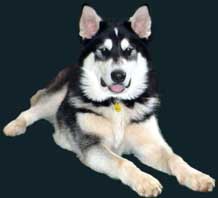
website design by Sheryl
bordered background by Sheryl
© 2005
all images © Sheryl Franklin unless elsewise attributed
all Alaskan Malamute sound files © Sheryl Franklin
website hosting by FranklinCommunications
domain name by DomainRegister.com
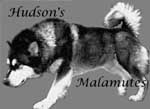
My Mals
Now
Sebastian
Cinnabar
Then
Wolf
Taylor
What's New
Purebred Dog Breeds into the 21st Century
